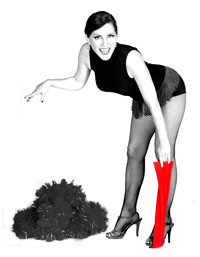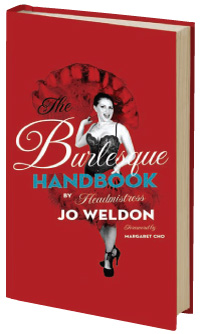Table of Contents
Preface viiBurlesque: A Foreword by Margaret Cho ix
Introduction: A Lifetime of Discovering Burlesque
and a Brief History of Bold Women 1
1 Inspiration: Your Internal Theater 23
Part I Burlesque Movement
2 Classic Moves: The Old-School Way 35
3 Pasties: They’re Revolutionary 55
4 Fans: Your Fine Feathered Friends 85
Part II Act Development
5 Music: The Basis of Every Successful Seduction 111
6 Costumes: Constructing Outfits for Deconstruction 125
7 Character: Getting Into It 153
Part III Refining Performance
8 Makeup and Hair: You’re Never Nude Up There 171
9 The Big Reveal: Getting a Gimmick 187
10 Backstage Etiquette: How to Win Naked Friends and Influence Nude People 201
Part IV Take a Bow
11 Identity: What Makes You So Special 217
Worksheets 232
Resources 243
Timeline 253
Glove Peel #2: The Glove Stand
(From Chapter 2: Classic Moves - Illustrated Step-by-Step Techniques)
 The Glove Stand is a smooth move that always gets lots of applause and adds an element of surprise to your glove peel. When you perform the Glove Stand, remember that how you rise from your seated position is as important as how you lower yourself into it. Throughout all the moves, take your time, and create a languorous tension in your body as if you were yawning or a cat stretching. This will define your muscles and project energy to the audience. Plus, it feels great!
The Glove Stand is a smooth move that always gets lots of applause and adds an element of surprise to your glove peel. When you perform the Glove Stand, remember that how you rise from your seated position is as important as how you lower yourself into it. Throughout all the moves, take your time, and create a languorous tension in your body as if you were yawning or a cat stretching. This will define your muscles and project energy to the audience. Plus, it feels great!
1. Show your left shoulder to the viewer—remember, when you took that breath you got them all excited about that shoulder—and slowly lower yourself to sit on your heels.
2. Slip the loosened fingers of your left glove, palm up, under your left foot and bear your weight upon them. The strength of your weight on the fingers will ensure a lovely gliding peel no matter how tight the glove.
3. Raise your hips while keeping your rib cage forward and down. After your hips come up, raise your upper torso, keeping your fingers slightly spread inside the glove in order to make sure it stays on your hand. Let your shoulder and hand follow your torso as you rise. Remember to... (continued on page 46)
Attaching The Pastie to Your Breast
(From Chapter 3: Pasties)
To adhere the pastie to a breast (or any other accessory to any other part of the body), most performers use one of these methods:
1. Latex glue. Make sure your skin is not powdery or oily. Smear eyelash or pastie glue in a thin layer on the inside of the pastie and let it dry. When you are ready to apply the pastie, do another thin layer around the areola and let that dry for a few minutes. You can also line the pastie with glue, press the pastie against your breast where you want to adhere it to smear glue from the pastie onto your breast, and let both those layers get mostly dry. There is no need to put glue directly onto the tippy tip of your nipple unless the pastie is going to touch that part of your breast; putting it against the skin just outside the areola of your nipple ought to do the trick and be more comfortable as well. When you press the tacky glue onto the dried glue, it will hold.
2. Two-sided tape. Make sure your skin is not powdery or oily. The type of two-sided tape intended to be used with paper isn’t desirable for this purpose, so use two-sided toupee or garment tape. Cut a strip in half and carefully apply it to the inside edge of the pastie. You want the tape to go as close as possible to the edge without sticking out on the sides; this way it stays on but doesn’t stick to your costumes or tassels. As with latex glue, it is not necessary for the adhesive to make contact with your nipple. Peel off the paper and press it onto your breast. The tape is usually not reusable. Some performers use spirit gum, which I personally find unbearable. If you find that your pasties aren’t staying on with either toupee tape or eyelash glue, however, you may decide to try it. I recommend checking out Mastix or Ben Nye’s brand of spirit gum and remover. Ben Nye products are designed for stage and costume and are high quality as well as reasonably priced. While living in New York I’ve become acquainted with many makeup artists, and all of them have at least a few BN products in their kits.
When you attach the pastie to your breast, keep in mind that the more room the tassel has to twirl, the easier it is to twirl. Most people’s nipples are slightly farther out to the sides or lower on their breasts than directly in the center. The center of your pastie should be centered on your breast rather than right over your nipple. Your nipple has to be covered, so that is a matter of experimenting with pastie size. You may have to experiment to find the perfect place for your pastie. Cheat it toward, if not directly into, the center. if you do this, make the pastie large enough to cover the bottom of your nipple as well as the center of your breast—not only does it look better, it may be legally required.
Because each person’s body, from shape to skin type to latex sensitivity, is so different, there is no one right truest way to make and adhere pasties that works for everybody. This is why learning to make your own pasties can be so beneficial. You may find that you can twirl tassels only when the pasties are made of raw bacon, the tassels are made out of violin strings, and they are adhered with organic coconut paste—if that works for you, you’re doing it right!
Backstage Guidelines
(From Chapter 3: Etiquette)
1. Ask before you take pictures, and be genuinely willing to not take them. People who don’t mind being photographed doing all kinds of wild things onstage may not want to be photographed checking the crotch of their underwear for clitty litter. Or they may wish to be photographed only by professionals. This is not necessarily uptight of them. There are a lot of issues around photography and burlesque. And for god’s sake, if you post a photo online and someone asks you to take a picture down, do it!
2. If someone is making a documentary about you, tell the show producer about it when you first discuss your booking rather than springing it on them right before the show. Most performers seriously don’t want your camera crew or photographer backstage, unless it is part of a carefully developed art project or prestigious news show, and sometimes not even then.
3. Do not perform numbers that are messy without prearranging it with the producer. If you leave water, confetti, glitter, wax, food, etc. onstage, you are affecting other performers. If there has to be a long cleanup between your act and the next one, you are also affecting the performers, so don’t assume it’s okay to make an unannounced mess just because you brought your cleanup crew—especially if your crew would be taking up valuable backstage space.
4. Don’t get drunk before the show unless the producer seems to be heartily endorsing it. I for one will not allow drunk performers onstage during my showcases.
5. Consider carefully whether or not eating backstage is a good idea. Protein bar, yes. Plate of spaghetti, no.
6. Until you get to know people, listen more and talk less. I am naturally loquacious, but I try not to make other people nervous with it.
7. Brush your teeth, chew gum, drink water. Everybody loves fresh breath. And bathe. Really. Even if your life partner has a fetish for stinky armpits. Please.
8. If you are genuinely upset about something, decide carefully whether you need to express your feelings immediately or if it can wait until after the show. Everyone is in a fragile and self-absorbed state immediately before and after performing.
9. Even if someone asks you, don’t critique them in front of anyone else. No matter what they say. Save it for a workshop.
10. Ask before bringing your dog backstage. And your boyfriend or girlfriend is probably even less welcome backstage than your dog, which at least everyone can pet.


